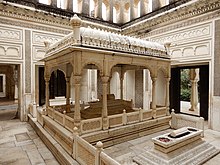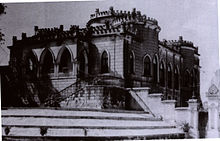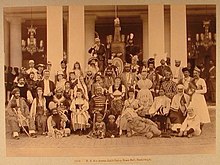| Revision as of 17:37, 27 July 2024 editJayowyn (talk | contribs)Extended confirmed users1,327 edits →History: copy edited personal titlesTag: Visual edit← Previous edit | Revision as of 17:45, 1 August 2024 edit undo2407:d000:f:2b79:b0ef:aebd:3bed:4bc5 (talk)No edit summaryTags: Reverted Mobile edit Mobile web editNext edit → | ||
| Line 68: | Line 68: | ||
| }} | }} | ||
| '''Paigah family''' was a ] family from the former ].<ref name="Faruqui">{{cite journal|title= At Empire's End: The Nizam, Hyderabad and Eighteenth-Century India|url= http://www.jstor.org/stable/20488070|last= Faruqui|first=Munsid. D|journal= Modern Asian Studies|page=22|year=2009|volume=43|number=1|publisher=]|doi= 10.1017/S0026749X07003290|jstor= 20488070|s2cid= 146592706|access-date=24 August 2020}}</ref> The family maintained their own court, individual palaces, and a standing army of about fourteen thousand infantry and cavalry troops.<ref>{{Cite book |url=http://archive.org/details/bhopal14 |title=bhopal14}}</ref> | '''Paigah family''' was a ] family of ] descent from the former ].<ref name="Faruqui">{{cite journal|title= At Empire's End: The Nizam, Hyderabad and Eighteenth-Century India|url= http://www.jstor.org/stable/20488070|last= Faruqui|first=Munsid. D|journal= Modern Asian Studies|page=22|year=2009|volume=43|number=1|publisher=]|doi= 10.1017/S0026749X07003290|jstor= 20488070|s2cid= 146592706|access-date=24 August 2020}}</ref> The family maintained their own court, individual palaces, and a standing army of about fourteen thousand infantry and cavalry troops.<ref>{{Cite book |url=http://archive.org/details/bhopal14 |title=bhopal14}}</ref> | ||
| == History == | == History == | ||
Revision as of 17:45, 1 August 2024
Noble family in the senior aristocracy of Hyderabad State
This article has multiple issues. Please help improve it or discuss these issues on the talk page. (Learn how and when to remove these messages)
|
| House of Paigah | |
|---|---|
| Noble family | |
 | |
| Country | Hyderabad State |
| Founder | Nawab Abu'l Fateh Khan |
| Titles | Shams ul-Umara.
Amir-i-Kabir. Bahadur. Imam Jang. Umdat-ud-Daula. Umdat-ul-Mulk. Namwar Jang. Umdat-ul-Mulk. Shams-ud-Daula. Shams-ul-Mulk. Amir-i-Akbar. Azam-ul-Umara. Rifa’at Jang. Inayat Jang. Waliyat Jang. Viqar ul-Umara. Iqtaidar ul-Mulk. Iqtaidar ud-Daula. Secundar Jang. Sultan ul-Mulk. |
| Members | Asman Jah and his son Moin-ud-Daula Bahadur Asman Jah, Zahir Yar Jung Viqar-ul-Umra and his son Sultan ul Mulk Khursheed Jah |
| Connected families | Asaf Jahi dynasty Salar Jung family Pataudi family Talpur dynasty Qu'aiti |
| Properties | Devdi Iqbal ud-Dowla Asman Garh Palace Paigah Tombs Paigah Palace Vikhar Manzil |
| Dissolution | 1948 (1948) |
Paigah family was a noble family of Punjabi descent from the former Hyderabad State. The family maintained their own court, individual palaces, and a standing army of about fourteen thousand infantry and cavalry troops.
History
The word Paigah, which means pomp and rank in Persian, was a title given by the second Nizam of Hyderabad to Nawab Abu'l Fateh Khan Tegh Jung Bahadur in appreciation of the royal services rendered by him. The Nawab was also conferred with the titles of Shams-ul-Umra ("The Sun among Nobles"), Shams-ul-Mulk, and Shams-ud-Daula. He became the founder of the Paigah family.
Shaikh Muhammad Bahauddin, who was Governor of Shikohabad under Mughal Emperor Aurangzeb, was the twelfth direct descendant of Shaikh Fariduddin Ganjshakar, a saint of the Indian subcontinent (now in Punjab, Pakistan).
Abul Khair Khan, son of Shaikh Muhammad Bahauddin, was in the service of Mughal Emperor Muhammad Shah. During this time, he was bestowed the title of Khan Bahadur. His statesmanship was noticed by Nizam-ul-Mulk (the then Prime Minister of Mughal, and later founder of Asaf Jahi dynasty and known as Nizam I) and was appointed as Deputy Governor of Malwa and Khandesh. He joined Nizam on his way to Deccan and accompanied him in the battles against Maratha. During Nizam I's campaign to Delhi in the process to negotiate and stop Nadir Shah, Khan safeguarded his Nizamat in Deccan and overthrow rebellion by his son Salabat Jung. During his career under Nizam I, he was appointed as Qila Dar of Dhar (1724), Faujdar of Nabinagar, Mandu (1724), and later elevated up to Naib Subadar-Deputy Governor Khandesh and Aurangabad. He died in 1952 and was buried in Burhanpur. His titles are Khan Bahadur, Shamsher Bahadur, and Imam Jang I.
Abul Khair Khan had two sons, his first Abul Barakat Khan Imam Jung II was shot to death during the lifetime of his father while inspecting the fort near Poona, which was captured from Maratha; he is buried in Burhanpur. His second son Abul Fateh Khan joined the services of Nizam II and was regarded as the head of Paigah. Paigah family. Appointed to a mansab of 7,000 zat and 5000, sowar 1777, prom. to 9,000 sowars and a Paigah contingent of 12,000 troops in 1781.Received the Naubat, Naqara, and Mahi Maratib (ensigns of royalty). Constructed Nai Haveli 1201H (1782 AD). Abul Fatah Khan died at Pongel while on his way to face Tipu Sultan during the 2nd Mysore War on 1 January 1791. Abul Fatah Khan was interred at Paigah Tombs beside the dargah of Beranashah Saheb. His titles at the time of his death were: Abul Fateh Khan, Abul Khair Khan II, Tegh Jung, Shums-ud-Dowlah, Shums-ul-Mulk, and Shams-ul-Umara I. He was survived by his son Shams-ul-Umra I and daughter Bibi Najeeba. (Commanded Battles: Battle of Udgir 1760 AD against Balaji Baji Rao Peshwa III, accompanied Nizam Ali Khan Asaf Jah II in all his campaigns, Commanded Campaign Adoni against Tipu Sultan 1200 H (1781 AD), Battle of Nirmal 1783 AD against Ehtasham Jung (Zafar ud Dowla Dhaunsa).
After Abul Fateh died in 1791, his son Fakhruddin Khan inherited the estates and titles. He was given the title Amir-e-Kabir, which meant Head of the Nobles. He also married the daughter of Nizam Ali Khan, Asaf Jah II Sahebzadi Bashirunissa Begum in 1797. Thus began the tradition of marrying Nizam's daughters to young men of the Paigah family. Fakhruddin Khan's grandson through his third son was Sir Asman Jah, Jah had one son Moin-Ud-Dowlah Bahadur Asman Jah who had 14 sons and 7 daughters, Fakhruddin Khan's fourth son Rasheeduddin Khan had two sons, Viqar-ul-Umra and Khurshid Jah.
Nawab Mohammed Iqbaluddin Khan son of Moin-Ud-Daula Bahadur was married to Sahebzadi Ahmed Unisa Begum maternal granddaughter of H.H Mahboob Ali Khan and parental granddaughter of Sultan ul-Mulk, Viqar-ul-Umrahi Iqtidar ud-Daula, he had 2 sons and 2 daughters, one of them is Sahebzade Nawab Muhammed Hyder Uddin Khan he was given this name by his uncle Mir Osman Ali Khan hyder nawab is also the owner of Chiraan Fort Palace, other half of Paigah Palace
Bashir Yar Jung, a grandson of Viqar-ul-Umra married Saleha Sultan, the daughter of Sajida Sultan and Iftikhar Ali Khan Pataudi. Their son Saad Bin Jung is a member of the Paigah family as well as Pataudi Royal Family.


Family and Amir's
At the death of Fakhruddin Khan Shams-ul-Umra I, the Paigah estate was divided between his two surviving sons : Rafiuddin Khan and Rashiduddin Khan. Rafiuddin Khan's titles at the time of death were: Abul Khair Khan IV, Namwar Jung, Umdat-ud-Doula, Shums-ud-Doula, Umdat-ul-Mulk, Shums-ul-Umara III, Amir-e-Kabir II. Rashiduddin Khan's titles at the time of his death were: Abul Khair Khan V, Bahadur Jung, Iqtidar-ud-Doula, Shums-ud-Doula, Iqtidar-ul-Mulk, Shums-ul-Mulk, Shums-ul-Umara IV, Viqar-ul-Umara I, Amir-e-Kabir III.
When Rafiuddin Khan died in 1877, his Paigah estate was inherited by his two adopted sons Sabaqat Jung (1839–1880) and Sir Asman Jah(1840–1898). However, when Sabaqat Jung died in 1880 without issue, his portion of the Paigah estate was divided into three parts and allocated between his brother Sir Asman Jah and his cousins Sir Khurshid Jah and Sir Viqar-ul-Umra. When Rashiduddin Khan died in 1881, his share of the Paigah estate was divided between his two sons Sir Khurshid Jah Bahadur (1841–1902) and Sir Viqar-ul-Umara Bahadur II (1856–1902). It was decided during this period that there would be no further divisions of the three estates. The Paigah estates were henceforth known as the Asman Jahi Paigah, Khursheed Jahi Paigah, and Viqar-ul-Umarahi Paigah.
Each of the three branches has its own Amir, appointed by the Nizam entirely at his own discretion. Preference was given to individuals whose mothers were daughters of the Nizam, provided that they were fit for the post, regardless of other seniority factors such as age. The newly appointed Amir would inherit the entire jaagir of the previous Amir and would be the ceremonial head of that branch of the Paigah family. The Nizam also had the authority to appoint one Amir from among the three Paigah Amirs to hold the honorary morchal (standard) behind the Nizam during Durbar.
According to the census of 1901, the three Paigah Estates in the Hyderabad State comprised 23 taluks dispersed over the districts of Bidar, Nander, Osmanabad, Gulbarga, Medak, Atraf-i-Balda, and Nizamabad, and a few scattered villages in Aurangabad, Warangal, Mahbubnagar, and Nalgonda, encompassing 1,273 villages, covering 4,134 square miles, over a population of 774,411 (The Imperial Gazetteer of India, vol. 1, 1909).








Family tree

- Asman Jah, Amir e Akbar, Nawab Sir Muhammad Mazhar ud-din Khan Bahadur son of Nawab Sultanuddin Khan (served as Prime Minister of Hyderabad)
- Amir-e-Paigah-e-Asman Jahi, Moin-ud-Daula Bahadur Asman Jah Innayat Jung, Nawab Muhammad Moin uddin Khan Bahadur
- Viqar ul Umra II, Iqtedar-ul-Mulk, Iqbal-ud-Dowla, Sikandar Jung Amir e Paigah, Nawab Sir Muhammad Fazl ud-din Khan Bahadur (served as Prime Minister of Hyderabad1893 to 1901).
- Nawab Fareed Nawaz Jung Bahadur(Third son of Nawab Sultan ul Mulk) Married to Princess Sahibzadi Ghous unnisa Begum (Daughter of Mir Mahboob Ali Khan *Asaf Jah VI Nizam) Their Daughter is member of both Nizam And Paigah
- Nawabzada Muhammad Saad Bin Jung
Relationship with the Nizams
The bond between the Nizams and the Paigah nobility strengthened with the marriage of Abul Fatah Khan's son Fakhruddin Khan with the daughter of Nizam Ali Khan, Asaf Jah II, Sahebzadi Bashirunissa Begum in 1797. Henceforth, Fakhruddin Khan's descendants married daughters of other Nizams and consequently, in protocol, the Paigahs were considered next only to the Nizams. The Paigah jagir was the largest in the state, second only to the Nizam.
The Paigah nobility, being sons-in-law and brothers-in-law to the Nizams, were to a certain extent above the law. The local police and courts did not have personal or in rem jurisdiction over their persons or property. They were subject only to the jurisdiction of the Nizam.
Tombs
Main article: Paigah TombsThe Paigah Tombs are the tombs belonging to the nobility of Paigah family. They were constructed over a period of time during the 18th, 19th and 20th centuries. They are located in the Santoshnagar locality of Hyderabad. The tombs are made of lime and mortar with beautiful inlaid marble carvings.
Places Named after the Paigah family
Vikarabad, a town in Telangana, is named after H.E Viqar-ul-Umra, and the town of Shamshabad, which houses the Rajiv Gandhi International Airport, is also named after The Shams-ul-umra family. Moinabad was named after Nawab Moin-Ud-Daula Bahadur Asman Jahi. The area of Begumpet was gifted to the Paigah family, when Abul Fateh Khan's son Fakhr uddin Khan was married to the daughter of Nizam Ali Khan, Asaf Jah II Sahebzadi Bashirunissa Begum. Basheerbagh is named after H E Sir Asman Jah Bahadur Basheer ud Daula.
Zaheerabad in Telangana is named after Nawab Zahir Yar Jung, Amir e Paigah Asman Jah.
Paigah Deodis and Estate
The Paigah noblemen were known for their residences, usually known as Devdis. Bashir Bagh Palace belonged to Sir Asman Jah, a Paigah Amir and Prime Minister of Hyderabad (1887–1893). Sir Vicar-ul-Umra, the Paigah Amir and the then prime minister of Hyderabad state 1894–1901 (also officiated as prime minister in 1893) presented Falaknuma palace in 1897, easily one of the most opulent palaces in the country, to the sixth Nizam, Mir Mahbub Ali Khan.
Other important Paigah Palaces were:
- Asman Garh Palace
- Paigah Palace
- Khursheed Jah Devdi
- Vikhar Manzil
- Devdi Iqbal ud-Dowla
- Basheer Bagh Palace
- Jahanuma Palace
- Khana Bagh City Palace
- Vilayat Manzil
- Vikhar Manzil
- Parwarish bagh palace
- Begumpet Paigah House Zaheer Yar Jung
- Saroornagar Devdi
See also
- Falaknuma Palace
- Paigah Tombs
- Chiraan Fort Palace
- Spanish Mosque
- Mahboob Chowk Clock Tower
- Nizamia observatory
References
- Faruqui, Munsid. D (2009). "At Empire's End: The Nizam, Hyderabad and Eighteenth-Century India". Modern Asian Studies. 43 (1). Cambridge University Press: 22. doi:10.1017/S0026749X07003290. JSTOR 20488070. S2CID 146592706. Retrieved 24 August 2020.
- bhopal14.
- Safvi, Rana (21 January 2018). "The Paigah's necropolis". The Hindu. ISSN 0971-751X. Retrieved 22 July 2018.
- ^ Lynton, Harriet Ronken; Rajan, Mohini (1974). The Days of the Beloved. University of California Press. ISBN 9780520024427.
- Mudiraj, Krishna Swamy K. (1929). Pictorial Hyderabad. Vol. 1. Read Book (2006). pp. 45–50. ISBN 9781846643651. Retrieved 6 August 2020.
- Borah, Prabalika M. (14 September 2012). "Saad's Jung". The Hindu.
- Sripada, Krishna (13 July 2017). "The Paigah Tombs: The lime and mortar wonders". The Hindu. ISSN 0971-751X. Retrieved 23 August 2018.
- "Forgotten Heritage: The Devdis of Hyderabad - Go UNESCO | GoUNESCO". www.gounesco.com. 2 February 2017. Retrieved 5 August 2018.
- "Devdi Khurshid Jah in a state of dilapidation | The Siasat Daily". archive.siasat.com. Retrieved 22 July 2018.
- Khan, Asif Yar (16 July 2014). "Khursheed Jah Devdi cries for attention". The Hindu. ISSN 0971-751X. Retrieved 22 July 2018.
- "Palace with a view". The Hindu. 24 March 2004. Retrieved 22 July 2018.


